Download Pdf [2,03 MB] - MTU Aero Engines
Download Pdf [2,03 MB] - MTU Aero Engines
Download Pdf [2,03 MB] - MTU Aero Engines
You also want an ePaper? Increase the reach of your titles
YUMPU automatically turns print PDFs into web optimized ePapers that Google loves.
The next generation of regional jets – the Mitsubishi Regional Jet (MRJ).<br />
The MRJ is a 70-to-90-passenger commercial<br />
transport to enter revenue service in 2013.<br />
The MRJ70 will be rated at 67 kilonewtons,<br />
the larger MRJ90 at a takeoff thrust of 76<br />
kilonewtons. Its market volume is estimated<br />
at 1,500 units. Official program launch is<br />
expected to occur this year. The Japanese<br />
opted for the geared turbofan on account of<br />
its 15 percent lower operating costs. “A<br />
major part of that is due to its lower fuel consumption,”<br />
Winkler says.<br />
Compared to today’s best-selling engines in<br />
this thrust class the new design offers a<br />
reduction of maintenance costs of 40 percent<br />
according to Robert Saia, Vice President<br />
Next Generation Product Family at Pratt &<br />
Whitney. “Additionally it is about ten decibels<br />
quieter.”<br />
The big advantage afforded by geared turbofans<br />
is their reduction gear, which decouples<br />
the fan from the remaining low-pressure system.<br />
That allows the components to run in<br />
their respective optimum speed ranges to<br />
improve efficiency. “By decoupling the fan it<br />
turns at a third of the speed of the rest of the<br />
low-pressure system. This way we can increase<br />
the speeds of the low-pressure compressor<br />
and turbine. Thus, for a given thrust<br />
range we can reduce the number of stages of<br />
the low-pressure compressor and the lowpressure<br />
turbine,” the American engineer<br />
says.<br />
The concept also enables bigger fan diameters<br />
to be selected, which in turn makes for<br />
larger bypass ratios and hence lower fuel<br />
consumption. “We try to make the fan as<br />
large as possible. The slower it turns the more<br />
efficient and quieter it gets,” explains Saia.<br />
At this time, negotiations are underway between<br />
<strong>MTU</strong> and Pratt & Whitney regarding<br />
the size of <strong>MTU</strong>’s stakes. “We’re seeking<br />
module responsibility in development and<br />
manufacturing,” Winkler confirms. The<br />
Munich people have set their sights on two<br />
components, hoping to bag a stake in the<br />
compressor, apart from the high-speed lowpressure<br />
turbine. For <strong>MTU</strong>, the bargaining<br />
position looks compelling, not least on account<br />
of the Germans’ low-pressure turbine<br />
expertise. That turbine is a key component of<br />
the geared turbofan. Says Winkler: “On the<br />
high-pressure compressor, we’re targeting<br />
the stake we already had in the experimental<br />
compressor. That would be the first four<br />
stages, which is about half the compressor.”<br />
Developed in partnership with Pratt &<br />
Whitney, this eight-stage high-pressure compressor<br />
has its first test phase behind it. “In<br />
the process, it attained its efficiency and stability<br />
goals throughout,” Winkler says. “It has<br />
a high 17:1 pressure ratio and its size is targeted<br />
at the potential successor models of<br />
the Airbus A320 and Boeing 737. In a downscaled<br />
version, the compressor will be used,<br />
for instance, also on the MRJ and<br />
Bombardier’s CSeries engine.”<br />
The aircraft of the Canadian CSeries are conceived<br />
to seat 110 and 130 passengers, and<br />
enter revenue service in 2013, like the MRJ.<br />
<strong>MTU</strong> estimates its market volume at roughly<br />
3,000 units in the approximately 102-kilonewton<br />
thrust range. The decisions made by<br />
the regional aircraft makers may point the<br />
way for the industry in general. The <strong>MTU</strong><br />
manager is confident that “if the geared turbofan<br />
actually prevails and meets expectations<br />
in this domain, that is sure to have a<br />
ripple effect on the next-generation singleaisle<br />
aircraft.”<br />
First results coming in from a geared turbofan<br />
demonstrator based on the PW6000<br />
speak for themselves. “We’ve met specifications<br />
for specific fuel consumption and effi-<br />
The geared turbofan demonstrator on Pratt & Whitney’s advanced test facility in West Palm Beach, Florida. The high-pressure compressor developed jointly by <strong>MTU</strong> and Pratt & Whitney on <strong>MTU</strong>’s test stand.<br />
ciency,” Winkler emphasizes. The demonstrator<br />
features a gearbox and a new lowpressure<br />
system including <strong>MTU</strong>’s high-speed<br />
low-pressure turbine. Compared with the<br />
standard PW6000, fuel consumption is much<br />
superior, albeit not yet comparable with later<br />
product applications that will come with a<br />
new core. Flight tests planned for mid-year<br />
are expected to demonstrate that capability<br />
also when airborne. But even idling on the<br />
test stand, the engine has impressed Winkler<br />
and his colleagues. “It’s so quiet you can keep<br />
up a conversation standing right next to it.”<br />
For additional information, contact<br />
Dr. Christian Winkler<br />
+49 89 1489-8663<br />
For interesting multimedia services<br />
associated with this article, go to:<br />
www.mtu.de/108GTF_E<br />
6 Cover Story<br />
7


![Download Pdf [2,03 MB] - MTU Aero Engines](https://img.yumpu.com/11154858/4/500x640/download-pdf-203-mb-mtu-aero-engines.jpg)


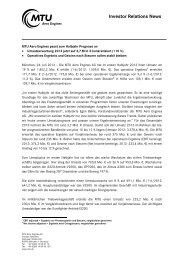
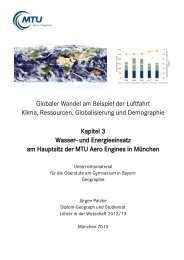
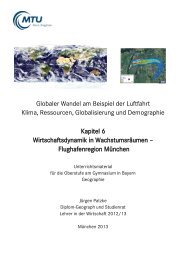
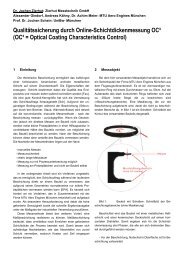
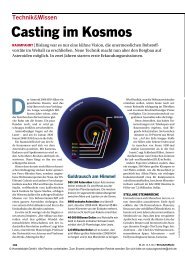

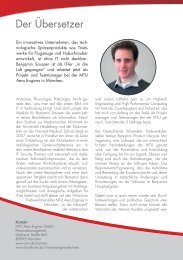
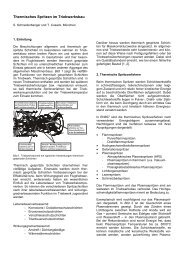
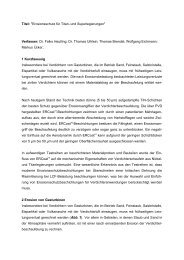


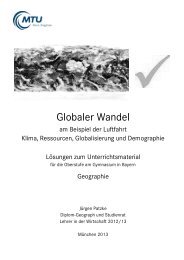
![Download PDF [5,37 MB] - MTU Aero Engines](https://img.yumpu.com/21945461/1/190x125/download-pdf-537-mb-mtu-aero-engines.jpg?quality=85)